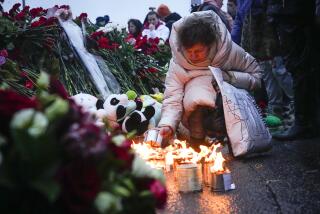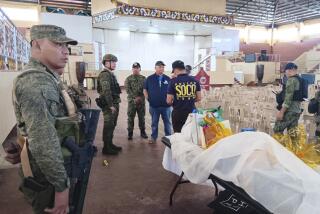Heart of Sri Lankan Capital Bombed; 60 Die
- Share via
COLOMBO, Sri Lanka — Suspected Tamil militants struck with deadly fury Wednesday in the heart of Sri Lanka’s capital, smashing a truckload of explosives into the Central Bank building and detonating a mammoth blast that killed at least 60 people, wounded as many as 1,400 and reduced much of Colombo’s business district to rubble and flames.
The suicide bombing was the most devastating and deadly attack in Sri Lanka’s most important city since armed insurgents in the Indian Ocean island nation began battling 12 1/2 years ago for a separate homeland for their Tamil minority.
The midmorning explosion on a working day left bodies strewn by the dozens on streets and in wrecked buildings. At least half a dozen high-rises caught fire, and the blazes kept police and rescue workers from digging through the debris for survivors.
Panicked workers, many of whose shirts or saris were soaked with blood, fled the downtown neighborhood on foot. Helicopters carried large buckets of water to douse the burning buildings and tried to rescue scores of frightened people trapped on upper floors.
Sri Lankan police today identified the suicide bomber as a member of the Liberation Tigers of Tamil Eelam, who have staged numerous suicide bombings in the past. Two other members of the group--arrested as they fled the scene in a hijacked scooter-rickshaw--participated in the attack, the police said.
“This incident has all the hallmarks of the [Tigers],” Ravinatha P. Aryasinha, the Foreign Ministry’s director of publicity, said Wednesday.
Military sources said the truck had been packed with 440 pounds of explosives.
Of the known wounded, 100 were in critical condition, hospital sources said. The casualty toll seemed certain to rise as rescue workers sifted the rubble in search of victims.
“There are still several people trapped inside the burning buildings. We have to first put out the fire and try to save as many as possible,” a police officer said. Officials said 3,000 people worked in the Central Bank building alone, and it could be days before rescue work is complete.
Thick black columns of smoke rose over the seaside district from the burning buildings, and the air was rent with the shrieks of ambulances.
The bombing showed that despite recent setbacks in the civil war, including the Tigers’ loss of their northern capital and citadel, Jaffna, in December, the rebels remain a deadly force to be contended with. They are clearly capable of piercing the heavy security cordons thrown up by the armed forces and police in Colombo.
The attack was also a blow to President Chandrika Kumaratunga’s effort to end the ethnically fueled strife that has claimed at least 39,000 lives since 1983. The Defense Ministry, in a statement, accused the Tigers of carrying out the bombing to generate “communal backlash” among the majority Sinhalese against Tamils.
There were conflicting reports about how the explosion occurred, but there appeared to be general agreement that the attackers drove an Indian-made truck into the security barricade outside the Central Bank, where Sri Lanka’s gold reserves are held and the country’s financial policy is made.
Some reports said one passenger carrying explosives on his body jumped out of the truck and detonated himself and the vehicle, while five accomplices escaped. Other reports said two men leaped from the truck and opened fire, scattering most of the bank’s security guards.
“It was a suicide mission,” one official told the United News of India agency. It was not immediately clear how many of the bombers died.
The explosion, so powerful it gouged an eight-foot crater in the ground and was heard miles away, caved in the front of the nine-story bank building and shattered nearby high-rises.
“Suddenly there was a terrific explosion,” S. Amarawati, whose blouse was stained with blood, told the Associated Press. “There were at least 12 or 13 people lying dead on the street.”
H. D. Peiris, a business executive, told the news service that he was on the street when the blast occurred.
“We saw cars burning. I ran as far as possible from the area,” he said. “As I was running, there was a second explosion. That caused more panic.”
Tourist hotels, travel agencies, airline offices, private banks and other businesses in Colombo’s oldest district were badly damaged. Millions of dollars of damage was done to the city’s 39-story twin-tower World Trade Center, which was still under construction.
Telephone service was knocked out, and many of the wounded had to be transported to hospitals in public buses or private cars.
The Central Bank, on one of the city’s busiest thoroughfares, is about 150 yards from the Presidential Secretariat. However, Kumaratunga, whose father and husband were assassinated, spends most of her time in the walled Temple Trees complex in another city neighborhood.
Hours after the huge explosion, an eyewitness said the scene in the capital of 1.2 million people was still one of “utter devastation and chaos.”
At least 1,000 police, army troops and civilian volunteers, many stunned by the magnitude of the death and destruction, were milling about streets strewn with broken glass.
A terrorist act of this type, if not on such a devastating scale, had been expected in the Sri Lankan capital, and roadblocks to guard against suicide car bombings had been erected around some buildings.
“Ever since the [government] campaign in Jaffna started in the middle of last year, we have been expecting the LTTE would do two things,” John Field, the British ambassador, told the British Broadcasting Corp. “One would be to up its attacks in the Eastern province, and the other would be some sort of terrorist activity in Colombo and that area.”
Field conjectured that the bombers’ real target may have been the headquarters of the Sri Lankan navy, near the bank.
The attack came two weeks after Kumaratunga offered a formal draft of a plan to give the Tamil minority more say over its own affairs.
Government officials said the attack seemed designed to torpedo the proposal, which mainstream Tamil political parties have welcomed with reservations.
“I think it’s particularly unfortunate that at a time when the whole country, including all Tamil political groups, are trying to . . . end this problem politically, the LTTE pursues a path of destruction,” said Aryasinha, the Foreign Ministry spokesman.
(BEGIN TEXT OF INFOBOX / INFOGRAPHIC)
Sri Lanka Fact Sheet
Population: 18 million
Recent history: Known to the ancient world as Taprobane, it was later called Serendip, from which the word “serendipity” was coined. In 1796 the British seized the island and it become part of the British empire under the name Ceylon. It became an independent member of the commonwealth in 1948 under the British monarch and in 1972 became a republic under the name of Sri Lanka.
Current crisis: After thousands were killed during an ultra-leftist campaign in the ‘70s, tensions exploded between the Buddhist Sinhalese and the predominantly Hindu Tamils, who felt they were discriminated against. The more extreme Tamil groups, who want to set up an indepedent state, have been accused of massacring villagers, as well as carrying out a campaign of assassination by suicide bombers who killed Sri Lankan President Ranasinghe Premadasa and former Indian Prime Minister Rajiv Gandhi.
Geography: A tropical island the size of West Virginia off the southern coast of India.
More to Read
Sign up for Essential California
The most important California stories and recommendations in your inbox every morning.
You may occasionally receive promotional content from the Los Angeles Times.












